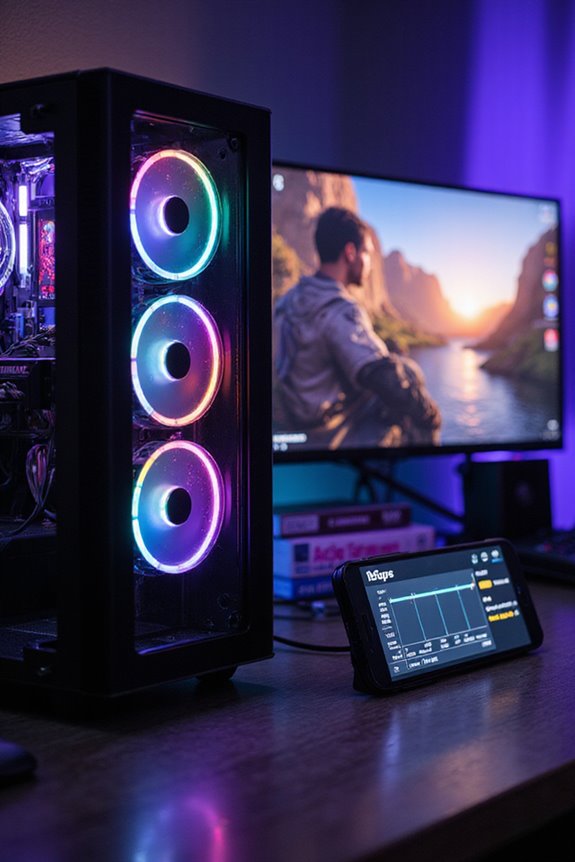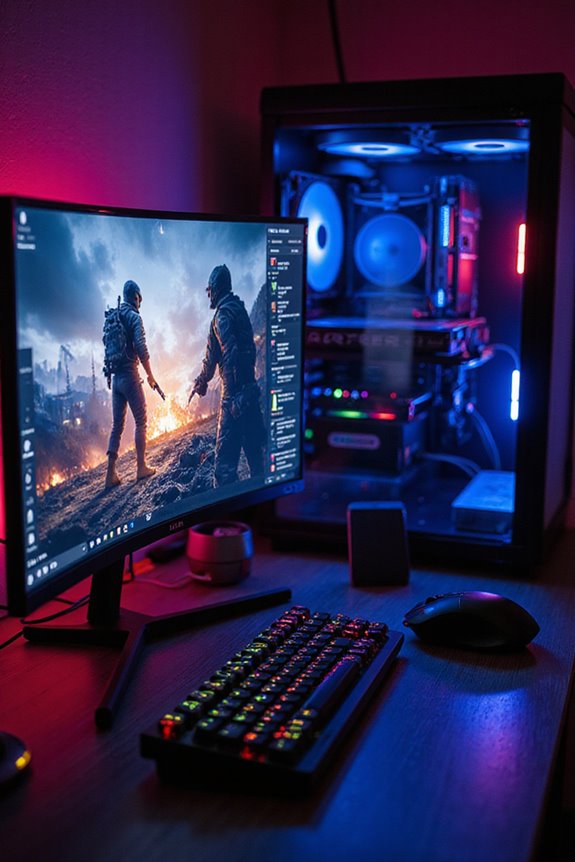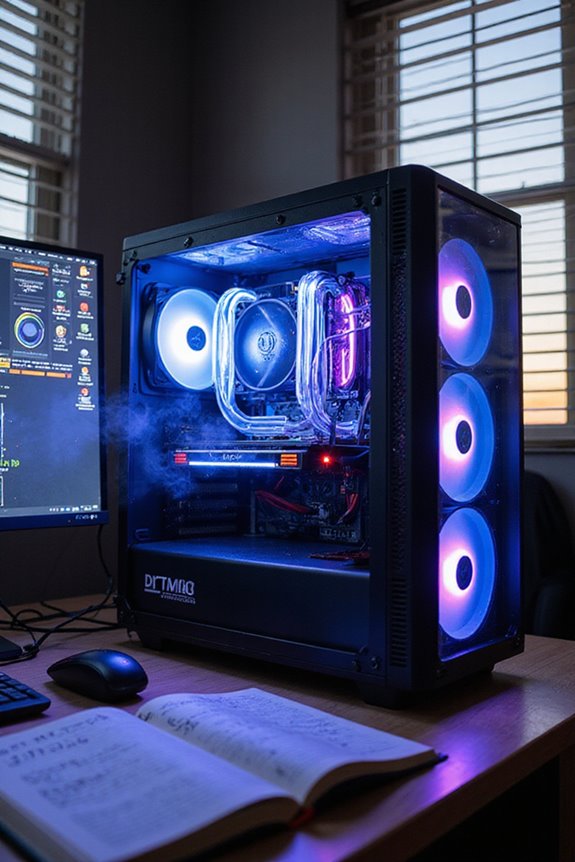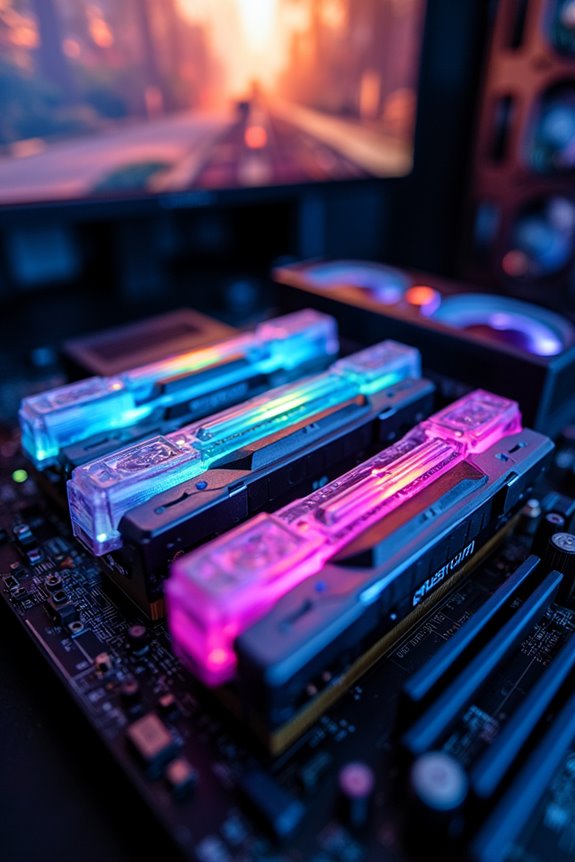In my experience, 16GB of RAM is generally sufficient for modern gaming. It can handle most AAA titles smoothly at medium to ultra settings while allowing for some multitasking, like streaming music. However, demanding games or mods might push it to its limits, leading to slowdowns. If you’re serious about gaming or want more future-proofing, you might consider 32GB for an extra performance boost. Stick around to uncover more insights on optimizing your gaming setup!
Key Takeaways
- 16GB RAM meets the minimum requirements for many modern AAA titles, providing smooth gameplay at medium to ultra settings.
- It supports multitasking, allowing users to game while running other applications like music or web browsers.
- However, it may struggle with resource-heavy games and mods that exceed 16GB memory usage.
- For serious gamers, upgrading to 32GB can enhance performance, especially in demanding scenarios and future-proofing against upcoming titles.
- Background processes can consume RAM, so managing applications is crucial for optimal gaming performance with 16GB.
Understanding the Baseline Functionality of 16GB RAM
When it comes to gaming, having 16GB of RAM is often seen as the sweet spot for performance. It meets the minimum requirements for most modern AAA titles, like Cyberpunk 2077, ensuring smooth gameplay at medium to ultra settings. I love how it allows me to multitask effortlessly; I can game while streaming music or browsing the web without noticeable lag. Plus, it offers a great balance between cost and performance, making it a smart choice for budget-conscious gamers. With 16GB, I’m also future-ready for upcoming releases that demand more memory. It pairs well with mid-to-high-end graphics cards, ensuring my gaming rig performs reliably without breaking the bank. Honestly, it’s just a solid investment for any gamer.
Performance Limitations of 16GB RAM in Gaming

While 16GB of RAM is often seen as a solid choice for gaming, it does have its performance limitations. You might find that some resource-intensive AAA titles, like “Hogwarts Legacy,” push the boundaries of what 16GB can handle. Even games like “Fortnite,” with all its add-ons, can exceed that threshold. Plus, if you’re into mods or high-resolution texture packs, you may experience slowdowns.
Balancing your RAM with GPU vRAM is essential, as peak performance usually requires system RAM to be at least double the vRAM. And don’t forget about cooling; overclocking can help, but it comes with risks. Ultimately, while 16GB works for many, it might not always deliver that smooth, consistent experience we crave.
Comparing 16GB RAM to 32GB RAM

Although 16GB of RAM can handle most gaming needs today, stepping up to 32GB offers some notable advantages that can enhance your experience. For instance, in more demanding scenarios, 32GB can provide up to 15% higher FPS and reduce stuttering, especially in open-world environments. You’ll notice smoother gameplay and fewer frame rate dips, which can be a game-changer during intense moments. Plus, with future titles likely requiring more memory, 32GB gives you the headroom to enjoy cutting-edge features without worrying about bottlenecks. While the upgrade isn’t “night and day,” it’s a solid investment for serious gamers looking to future-proof their systems. So, if you can swing it, 32GB might just be the way to go.
The Impact of Multitasking and Background Processes

Even if you’ve got 16GB of RAM, multitasking can really change the game when it comes to gaming performance. When I’m playing and have Chrome open with a dozen tabs, or if I’m streaming on Discord, I can feel the difference. Background processes, like those updates sneaking in, can quietly munch away at my RAM, leaving less for the game. Running resource-heavy applications alongside a game often demands more than 16GB for that buttery smooth experience. I’ve found that closing unnecessary apps helps manage my RAM effectively, ensuring my gaming sessions remain enjoyable. It’s all about prioritizing what’s essential; after all, nothing beats a seamless gaming experience when every frame counts.
DDR4 vs. DDR5 Memory: What to Consider

When you’re diving into the world of gaming and performance, one of the first decisions you’ll face is whether to stick with DDR4 or make the leap to DDR5 memory. DDR5 brings higher speeds and bandwidth—think DDR5-4800 or even DDR5-6400—offering up to an 11% boost in gaming at 1080p, especially in those tricky 1% low performance metrics. However, it’s essential to evaluate your budget; DDR4 is more affordable and works just fine for less demanding games or older systems. If you’re playing at higher resolutions or using demanding applications, DDR5 can be a game-changer. Just remember, upgrading often means a new motherboard, so weigh your options carefully.
Future-Proofing Your Gaming Setup
Upgrading your RAM isn’t just about keeping pace; it’s about staying ahead. Sure, 16GB is enough for most games today, but as titles evolve, the demand for memory will likely increase. I’ve noticed that high-end games often recommend at least 16GB for a smooth experience, and that’s where future-proofing comes in. Consider this: investing in 32GB or more can greatly enhance performance, especially for resource-heavy games or when multitasking with streaming software. Plus, fewer stutters and faster load times make a world of difference. While 16GB is budget-friendly, it may not keep up with the games of tomorrow. A thoughtful upgrade can guarantee your setup remains relevant and enjoyable for years to come.
Recommendations for Upgrading RAM
As you think about upgrading your RAM, it’s essential to reflect not just the quantity but also the type and speed. Moving from 16GB to 32GB can considerably reduce stuttering and lag, especially if you’re running background apps like Steam or messaging services. I recommend considering DDR5, as it offers higher speeds and better future-proofing compared to DDR4. Before upgrading, though, check if your motherboard supports it. It’s also wise to monitor your system’s performance; if other components like the GPU are bottlenecks, RAM alone won’t solve your issues. Remember, while it can be a cost-effective upgrade, assess your gaming habits and budget to make sure it aligns with your needs.
Frequently Asked Questions
Can I Play Older Games With 16GB RAM Without Issues?
Imagine a cozy library, filled with classic games. With 16GB RAM, I’ve found it’s like having ample shelf space; older games run smoothly, letting me plunge into nostalgia without interruptions, even when multitasking isn’t on my agenda.
How Does RAM Speed Affect Gaming Performance?
I’ve found that RAM speed truly impacts gaming performance. Faster RAM boosts data transfer rates, smoothing out gameplay and improving FPS, especially in CPU-intensive games. Balancing speed with capacity is essential for an ideal experience.
Will 16GB RAM Affect Game Loading Times?
I’ve noticed that with 16GB RAM, my game loading times are faster and I experience less lag. It really makes a difference, especially when I’m juggling multiple tasks while gaming. It’s been a solid choice for me.
Can I Mix Different RAM Sizes in My System?
Did you know that mixing RAM sizes can reduce performance by up to 20%? I’ve found it’s best to match RAM sticks for stability and speed; otherwise, you might face unexpected issues down the line.
What Are the Signs I Need More RAM While Gaming?
When I notice low frame rates or constant stuttering during gameplay, it’s a clear sign I might need more RAM. It’s frustrating, but upgrading can make my gaming experience so much smoother and enjoyable.





